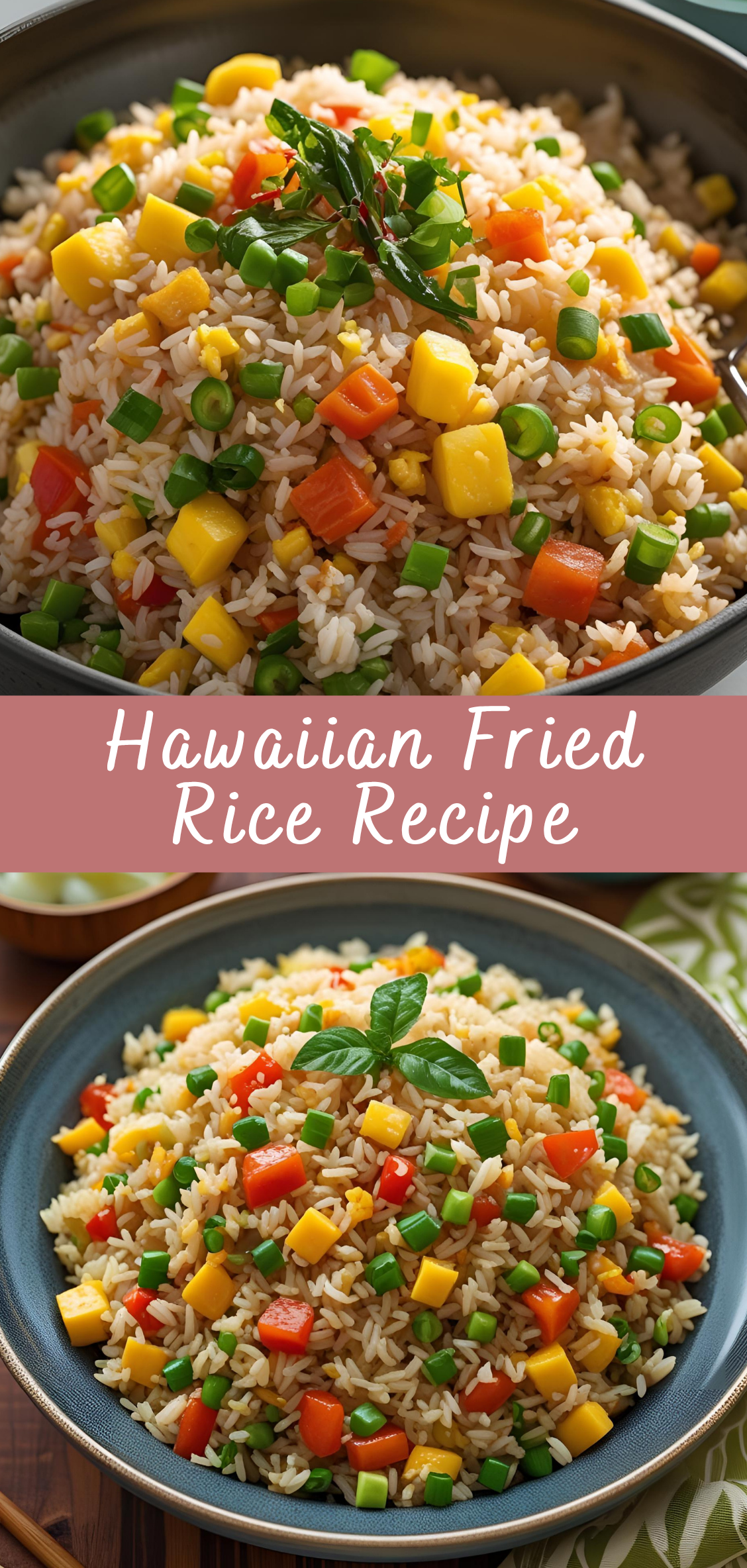Hawaiian Fried Rice Recipe
Few dishes achieve the delicate balance of comfort, versatility, and bold flavor quite like fried rice. Found in countless variations across cultures—from Chinese takeout staples to Thai basil versions and Korean kimchi-infused rice—fried rice has become an adaptable global favorite. But among its many interpretations, one version stands out for its unexpected twist: Hawaiian Fried Rice.

This colorful, sweet-savory dish is more than just an island spin on a classic; it’s a celebration of Hawaii’s rich multicultural culinary identity. Combining elements of East Asian stir-fry traditions with the tropical abundance of the islands, Hawaiian Fried Rice is hearty, flavorful, and bursting with personality. At its heart, it takes the structure of traditional fried rice—day-old rice stir-fried with aromatics, vegetables, and protein—and infuses it with ingredients like juicy pineapple, smoky ham, and sometimes even bacon or Portuguese sausage. The result is a dish that is deeply satisfying yet playful, and as suitable for a quick weeknight dinner as it is for a festive luau-style gathering.
Why Hawaiian Fried Rice?
Hawaiian Fried Rice is unique in how it embraces contrast: smoky meats versus sweet fruit, salty soy sauce against subtle hints of sugar, chewy grains beside tender vegetables. This balance of flavor and texture is the key to its appeal. While traditional fried rice tends to lean heavily on soy sauce, sesame oil, and vegetables, Hawaiian Fried Rice adds tropical flair with caramelized pineapple and rich, fatty proteins that pay homage to the local tastes and cultural fusions found throughout the Hawaiian Islands.
What truly elevates this dish is its adaptability. It’s perfect for using up leftovers—cold rice, bits of ham, vegetables in the back of your fridge—yet it’s also worthy of fresh preparation. It’s easily adjusted to suit dietary needs, too: swap white rice for brown rice or cauliflower rice, use tofu instead of pork, or increase the veggies for a lighter meal.
In this guide, we won’t just give you a recipe—we’ll walk you through every component of the dish, from the importance of cold rice and how to choose the right pineapple to the seasoning ratios that bring everything into balance. We’ll explore the cultural origins and evolution of the dish, techniques for perfect stir-fry execution, and several variations (like spicy, vegetarian, or seafood versions) that ensure this dish never gets boring.
Hawaiian Food Culture and Fusion
Hawaiian Fried Rice is a great lens through which to explore Hawaii’s diverse food culture. Native Hawaiian cuisine centered around ingredients like taro, sweet potatoes, and fish. But after the arrival of immigrants from China, Japan, the Philippines, Korea, Portugal, and other parts of the world in the 19th and 20th centuries, Hawaii’s food landscape transformed. Each group brought its own culinary traditions, which over time fused into what is now known as “local food”—a melting pot cuisine that includes plate lunches, loco moco, spam musubi, and, of course, fried rice.
Pineapple, a now-iconic ingredient in Hawaiian dishes, was introduced during the agricultural boom when plantations dominated the islands. It became a symbol of the tropics, and while not native to Hawaii, its use in local cuisine became widespread—especially in homes where leftover pineapple from canning operations was readily available.
Similarly, ham and Portuguese sausage reflect the multicultural nature of the dish. Ham often came from canned meat supplies, while Portuguese sausage (linguiça) was introduced by Portuguese immigrants. Both add a smoky, savory component that contrasts beautifully with pineapple’s sweetness.
In Hawaiian Fried Rice, all these elements come together—pork, fruit, rice, and vegetables—in a single wok or skillet, representing not just culinary creativity, but cultural unity.
The Anatomy of a Great Fried Rice
Perfecting fried rice is as much about process as it is about ingredients. Hawaiian Fried Rice, while simple in appearance, benefits from a few professional techniques that elevate the dish from good to great:
-
Cold, dry rice: The single most important rule for fried rice. Fresh rice is too moist and will clump or turn mushy in the pan. Cold rice (preferably made a day ahead and chilled) separates easily and crisps well under heat.
-
High heat stir-fry: Using a hot wok or large skillet ensures ingredients cook quickly and develop that signature “wok hei” (the smoky, charred flavor associated with high-heat Asian cooking).
-
Layering flavors: Adding ingredients in stages—starting with aromatics like garlic and onion, then proteins, vegetables, and rice—helps build flavor at every level.
-
Balance: Hawaiian Fried Rice walks a fine line between sweet and savory. A touch of brown sugar or honey amplifies the pineapple’s sweetness, while soy sauce and sesame oil ground the dish with umami.
-
Color and texture: Bright vegetables and well-seared meat make the dish visually appealing and offer textural variety.
Ingredient Breakdown: Building Blocks of Hawaiian Fried Rice
The beauty of Hawaiian Fried Rice lies in its perfect balance of sweet, savory, and smoky flavors—all built from a relatively short list of accessible, everyday ingredients. Each component plays a specific role, whether it’s adding texture, enhancing umami, or brightening the dish with tropical notes. Below, we break down every element so you understand not only what to use, but why it matters and how to customize it to your taste or dietary needs.
1. Cooked, Cold Rice
Recommended Amount:
4 cups of cooked white jasmine or long-grain rice, chilled overnight
Why It Matters:
Rice is the heart of any fried rice dish. To get the ideal texture—distinct grains that don’t clump or turn mushy—you need rice that’s dry and firm. Freshly cooked rice is too soft and moist for stir-frying; chilling it overnight dries it slightly, making it perfect for high-heat cooking.
Best Types of Rice:
-
Long-grain white rice: Fluffy with separated grains—ideal for stir-frying
-
Jasmine rice: Slightly aromatic, adds subtle fragrance
-
Brown rice: Chewy and more nutritious; a great whole-grain alternative
-
Cauliflower rice: Low-carb substitute; requires much less cook time
Pro Tip:
If you don’t have time to chill your rice overnight, spread freshly cooked rice on a baking sheet and place it uncovered in the refrigerator or freezer for 20–30 minutes.
2. Pineapple
Recommended Amount:
1 cup diced pineapple (fresh or canned, drained well)
Why It Matters:
Pineapple is what gives Hawaiian Fried Rice its signature tropical twist. The fruit adds sweetness, juiciness, and a hint of acidity that brightens the dish. When caramelized slightly during cooking, it intensifies in flavor and complements the savory ingredients beautifully.
Fresh vs. Canned:
-
Fresh pineapple: More vibrant and firm; cut into small chunks
-
Canned pineapple: Convenient, but be sure to drain excess juice
-
Grilled pineapple: Adds extra smokiness and depth
Substitutions:
-
Mango (firm, not overly ripe)
-
Papaya (adds a milder sweetness)
-
Leave out for a strictly savory profile
3. Ham or Spam
Recommended Amount:
1 cup diced ham or Spam
Why It Matters:
Smoky, salty ham (or Spam) is a nod to Hawaiian local-style cooking, where cured meats are common in comfort food. These proteins add richness and umami, creating a savory foundation that contrasts with the pineapple’s sweetness.
Options to Consider:
-
Ham steak or leftover holiday ham
-
Spam: Iconic in Hawaii and deeply flavorful when browned
-
Portuguese sausage: Spicier and more robust; slice thin and sear
-
Bacon or pancetta: Crispy texture and strong smoky flavor
Vegetarian Alternatives:
-
Smoked tofu or tempeh
-
Mushrooms (shiitake or cremini) for an umami boost
-
Plant-based sausage crumbles
4. Eggs
Recommended Amount:
2 large eggs, beaten
Why It Matters:
Eggs add protein and softness, enriching the dish and providing textural variety. They also soak up flavor from the pan and contribute to the dish’s golden color.
How to Use:
Push rice to the side and scramble eggs in the same pan or cook them separately and fold them in toward the end.
Additions:
-
A splash of sesame oil in the eggs can enhance aroma
-
Add extra yolks for creaminess or egg whites for lighter texture
5. Vegetables
Recommended Amount:
1½ to 2 cups total, diced small for even cooking
Common Veggies Used:
-
Green peas: Sweet and tender; adds color and contrast
-
Carrots: Diced or shredded; brings natural sweetness and crunch
-
Green onions: Fresh, peppery; added at the end for brightness
-
Red bell peppers: Bright, crisp, and slightly sweet
-
White or yellow onion: Adds a base layer of sweetness
Optional Add-ins:
-
Corn (especially sweet corn kernels)
-
Edamame (shelled soybeans)
-
Cabbage (finely shredded)
-
Water chestnuts for crunch
Substitution Tips:
Use whatever you have on hand—just aim for color contrast and a mix of soft and crisp textures.
6. Garlic and Ginger
Recommended Amount:
2 cloves garlic, minced
1 teaspoon freshly grated ginger (optional)
Why It Matters:
Garlic is foundational for aroma and depth. Ginger adds a warm, slightly spicy undertone that pairs especially well with the pineapple and pork.
Cooking Tip:
Sauté garlic and ginger in oil before adding the rice to release their essential oils and avoid bitterness.
Substitutions:
-
Garlic powder or ginger powder (½ tsp each if fresh is unavailable)
-
Shallots for a sweeter garlic-onion hybrid
7. Soy Sauce (and Optional Seasonings)
Recommended Amount:
2–3 tablespoons soy sauce
1 teaspoon sesame oil (optional)
½ teaspoon fish sauce (optional but adds umami depth)
Black pepper to taste
Why It Matters:
Soy sauce is your primary seasoning—it brings saltiness and a touch of savoriness. Sesame oil adds nuttiness, and fish sauce contributes a subtle anchovy-like depth.
Flavor Customization Options:
-
Add a dash of oyster sauce for richness
-
A spoonful of hoisin for a sweet-savory glaze
-
Chili garlic sauce or Sriracha for heat
Low-Sodium Option:
Use low-sodium soy sauce and season with a pinch of salt if needed.
8. Oil for Stir-Frying
Recommended Amount:
2 tablespoons neutral oil (canola, vegetable, or avocado oil)
Why It Matters:
A high-smoke-point oil is crucial for stir-frying, which requires quick, high-heat cooking. Neutral oils ensure the ingredients shine without an overpowering base flavor.
Best Choices:
-
Canola or vegetable oil (budget-friendly, neutral)
-
Peanut oil (slightly nutty and great for high heat)
-
Avocado oil (healthy and heat-stable)
Avoid:
Olive oil (low smoke point) unless used at the end for finishing
9. Garnishes (Optional but Recommended)
Ideas to Finish the Dish:
-
Chopped scallions (for freshness)
-
Toasted sesame seeds (for texture and nuttiness)
-
Chopped cilantro (if desired)
-
Lime wedges (to brighten the plate)
-
Fried shallots or crispy garlic (for crunch)
Pantry Checklist Summary
-
Cold cooked rice
-
Pineapple (fresh or canned)
-
Ham, Spam, or sausage
-
Eggs
-
Vegetables: peas, carrots, onions, bell peppers
-
Garlic and optional ginger
-
Soy sauce
-
Oil for stir-frying
-
Optional: sesame oil, fish sauce, hot sauce
-
Garnishes: green onions, sesame seeds, cilantro
Hawaiian Fried Rice Recipe
Few dishes achieve the delicate balance of comfort, versatility, and bold flavor quite like fried rice. Found in countless variations across cultures—from Chinese takeout staples to Thai basil versions and Korean kimchi-infused rice—fried rice has become an adaptable global favorite. But among its many interpretations, one version stands out for its unexpected twist: Hawaiian Fried Rice.
Ingredients
- 3 cups cooked rice (preferably day-old, jasmine or long-grain)
- 1 tbsp vegetable oil (or sesame oil for extra flavor)
- 2 eggs, beaten
- 1 cup diced ham (or spam, optional)
- 1/2 cup diced pineapple (fresh or canned, drained)
- 1/2 cup frozen peas and carrots (thawed)
- 1/4 cup chopped green onions
- 2 cloves garlic, minced
- 2–3 tbsp soy sauce (to taste)
- 1 tsp sesame oil (optional, for finishing)
- Salt and black pepper, to taste
Instructions
- Heat oil in a large skillet or wok over medium-high heat.
- Scramble eggs: Push to one side once cooked.
- Sauté ham until lightly browned (2–3 minutes). Add garlic, peas, carrots, and pineapple. Cook another 2–3 minutes.
- Add rice to the skillet. Stir well, breaking up clumps and mixing everything together.
- Season with soy sauce, sesame oil (if using), salt, and pepper. Stir until everything is evenly coated and heated through (about 3–5 minutes).
- Toss in green onions, stir once more, and serve hot!
Notes
- Day-old rice works best for fried rice—it’s less sticky and fries better.
- Add a dash of sriracha or chili flakes if you want a spicy version.
- You can swap ham with chicken, shrimp, or tofu.
- For extra Hawaiian flair, top with toasted coconut flakes or a fried egg.



